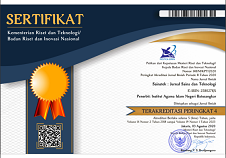Ethnobotany of Plants as Traditional Food Additives by the Community in Sitellu Tali Urang Jehe Sub-District Pakpak Bharat District
Abstract
Ethnobotany is a science that studies the relationship between humans and plants. This study aims to find out what types of plants are found and used as food additives traditionally, to find out which plant organs will be used as food additives traditionally, and to determine the cultural significance index/Cultural Significance Index (ICS) plants used as traditional Food Additives (BTP) in Sitellu Tali Urang Jehe District. This research is qualitative research and quantitative research. Qualitative research was carried out by calculating the presentation of plant species, and plant organs and calculating cultural interest index values, while qualitative research was carried out by participatory observation, where the researcher was involved in the informants' daily activities. The results of the study obtained 7 typical traditional plants used as food additives namely Rhinacanthus sp, Acmella oleracea (L.) R.K. Jansen, Curculigo sp, Zanthoxylum piperitum, Etlingera elatior J, Allium schoenoprasom and Solanum sp. Based on the research results, it can be concluded that there are 26 plant species belonging to 13 families. Plant organs used in food additives are: Leaves 27%, Rhizomes 23,1%, Fruits 34,6%, Stems 3,8% and Tubers 11,5%. The calculation of the ICS value of shallot plants has the highest preference or importance value among other plants, namely 50, while cassava leaves and lime recipes have the lowest importance value among other plants, namely 4.
Keywords
Full Text:
PDFReferences
Apriliani, A., Sukarsa, S., & Hidayah, H. A. (2014). Kajian Etnobotani Tumbuhan Sebagai Bahan Tambahan Pangan Secara Tradisional Oleh Masyarakat Di Kecamatan Pekuncen Kabupaten Banyumas. Scripta Biologica, 1(1), 78. https://doi.org/10.20884/1.sb.2014.1.1.30
Hume, C., Grieger, J. A., Kalamkarian, A., D’Onise, K., & Smithers, L. G. (2022). Community gardens and their effects on diet, health, psychosocial and community outcomes: a systematic review. BMC Public Health, 22(1). https://doi.org/10.1186/s12889-022-13591-1
Koay, W. I., & Dillon, D. (2020). Community gardening: Stress, well-being, and resilience potentials. International Journal of Environmental Research and Public Health, 17(18), 1–31. https://doi.org/10.3390/ijerph17186740
Maruapey, A., Ohorella, S., & Karepesina, S. (2022). Nilai Kepentingan Budaya Keanekaragamaan Jenis Sayuran Indegenous Dalam Kehidupan Masyarakat di Kampung Sire Distrik Mare Timur Kabupaten Maybrat Papua Barat. Jurnal Agrohut, 13(1), 11–24. https://doi.org/10.51135/agh.v13i1.119
Nurhidayah, Y., Lovadi, I., & Linda, R. (2015). Tumbuhan Berpotensi Bahan Pangan di Desa Sebangun Kecamatan Sebawi Kabupaten Sambas. Protobiont, 4(1), 151–159.
Nurrahmah. (2021). Potensi Etnobotani Pemanfaatan Tanaman Pangan Dan Obat Pada Hutan Produksi Di Desa Sepakat Kecamatan Masamba Kabupaten Luwu Utara. Universitas Muhammadiyah Makasar.
Rukmana, R., & Zulkarnain, Z. (2022). Etnobotani Tanaman Obat Famili Zingiberaceae Sebagai Bahan Herbal Untuk Kesehatan Di Masa Pandemi Covid-19. Teknosains: Media Informasi Sains Dan Teknologi, 16(1), 74–80. https://doi.org/10.24252/teknosains.v16i1.25970
Sari, S. K. (2017). Penggunaan Bahan Tambahan Pangan Oleh Para Pedagang Jajanan Di Sekolah Dasar Kecamatan Padang Utara. Social Science Journal, 14(1).
Simanullang, E., Chatri, M., Fevria, R., & M., D. M. (2021). Ethnobotany plants as traditional food additives in buffalo curry in pasar terandam village, barus district, central tapanuli regency. Bioscience, 5(2), 111. https://doi.org/10.24036/0202152109798-0-00
Suroto. (2016). Analisa Bioktif dan Pemanfaatan Bawang Tiwai (Eleutherine Americana. Merr) Untuk Bahan Tambahan Pangan. Jurnal Riset Teknologi Industri, 1(2), 24. https://doi.org/10.26578/jrti.v1i2.1399
Susandarini, R., Khasanah, U., & Rosalia, N. (2021). Ethnobotanical study of plants used as food and for maternal health care by the malays communities in kampar kiri hulu, riau, indonesia. Biodiversitas, 22(6), 3111–3120. https://doi.org/10.13057/biodiv/d220613
Umartani, L. A. (2020). Bahan Pangan Masyarakat Baksari Dan Ngarsapura, Mliwis, cepogo, Boyolali, Jawa Tengah. Universitas Islam Negeri Sunan Kalijaga Yogyakarta.
DOI: http://dx.doi.org/10.31958/js.v15i2.9076
Refbacks
- There are currently no refbacks.
Copyright (c) 2023 Firra Syahfitri, M Idris, Zahratul Idami

This work is licensed under a Creative Commons Attribution-NonCommercial-NoDerivatives 4.0 International License.
Indexed by:
__________________________________________________________________________
Sainstek: Jurnal Sains dan Teknologi
ISSN 2085-8019 (print) | 2580-278x (online)
Published by Institut Agama Islam Negeri Batusangkar
Email: sainstek@iainbatusangkar.ac.id
This work is licensed under a Creative Commons Attribution-NonCommercial-NoDerivatives 4.0 International License.















